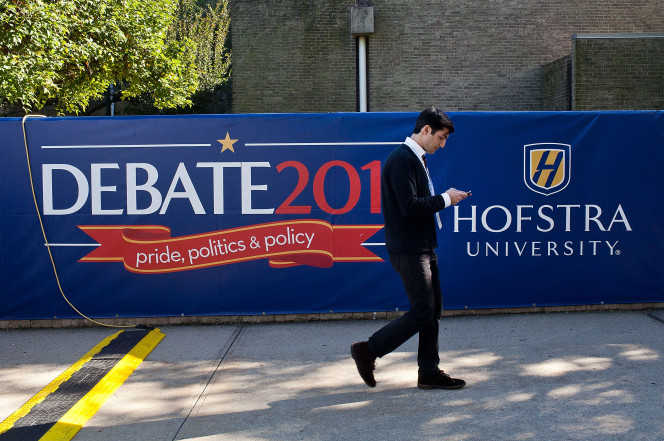
The uniquely uncivil presidential campaign is about to produce one of the biggest civic gatherings in decades: For 90 minutes on Monday night, a polarized nation will pause to watch the first head-to-head encounter between Hillary Clinton and Donald J. Trump.
The total audience, network executives and political strategists say, could be as high as 100 million viewers — Super Bowl territory. That would surpass the 80 million who watched Jimmy Carter and Ronald Reagan in 1980, the record for a presidential debate, and rank among television benchmarks like the finales of “MASH” and “Cheers.”
Not all viewers will watch from their living rooms. At the Dreamland Theater in tiny Nantucket, Mass., so many are expected for a debate-watching party that the town assigned a police officer to stand watch in case of rowdiness.
In Paris, many of those abroad for Fashion Week are setting middle-of-the-night alarms so they can watch the debate live — at 3 a.m. local time. “I need to feel like I’m part of this,” said Laura Brown, InStyle’s editor in chief.
Interest in the Debates
It has been estimated that as many as 100 million people will watch the first Clinton-Trump debate, an all-time record.
And in Richardson, Tex., the Alamo Drafthouse had to switch to a bigger room after overwhelming interest in a screening with refreshments like a “build a wall around it” taco salad.
Mass experiences — built around news events like the moon landing, and pop culture moments for older generations like the “Who shot J. R.?” episode of “Dallas” — are rare in an age of fragmented media and the drift toward partisan outlets, where viewers can effectively choose their own news.
But tight polls and curiosity about the unconventional Mr. Trump are luring viewers. In a New York Times/CBS News poll this month, 83 percent of registered voters said they were very or somewhat likely to watch on Monday.
“It’s a throwback to a phenomenon that has essentially disappeared in the era of digital media,” said Andrew Heyward, a former president of CBS News. “This is Americans gathering around the electronic hearth.”
Advertisers, including Audi cars and Tecate beer, are taking advantage, introducing debate-themed commercials in the kind of tie-in marketing usually reserved for events like the Super Bowl. Although the debate will air without commercials, cable and broadcast channels have sold millions of dollars’ worth of ads for programming before and afterward.
Photo
Monday’s first presidential debate will be held on a spare stage on the campus of Hofstra University on Long Island. Credit George Etheredge for The New York Times
Television networks and online streaming sites, including Facebook and Twitter, will carry the same feed on Monday, showing a spare debate stage at Hofstra University, on Long Island, a format that predates the blaring graphics and space-age sets that now dominate television news.
Still, even if a large portion of the country is watching, what Americans see may be as much about their beliefs and preferred news outlets as what transpires onstage.
About 8 percent of registered voters remain undecided, according to the New York Times/CBS News poll, a thin if crucial sliver of the electorate. And after Mrs. Clinton and Mr. Trump conclude on Monday, viewers are likely to return to their ideological silos, absorbing instant analysis from left-leaning anchors on MSNBC or commentators at right-leaning outlets like Breitbart News.
The debate itself will be subject to instant, blow-by-blow interpretation on social media.
“Regardless of where you’re watching, whether it’s Facebook Live or NBC or Fox News, there will be a moment where we all witness it,” said Charles L. Ponce de Leon, author of “That’s the Way It Is,” a history of television news. “But that moment will quickly crumble when all the instant analysis and opining comes into play.”
The event’s impact is unlikely to rival that of, say, 1960, when John F. Kennedy’s smooth performance in the first televised debate helped sway voters against his opponent, Richard Nixon. That debate aired without commentary — or graphics and captions on the screen. “Journalists were of the opinion they should wait and ruminate and think about what went down, and then, a day or a week later, talk about it,” Mr. de Leon said.



Expositores: Oscar Vidarte (PUCP) Fernando González Vigil (Universidad del Pacífico) Inscripciones aquí. Leer más
Una retrospectiva para entender los próximos cuatro años. Leer más
En la conferencia se hará una presentación de los temas más relevantes del proceso de negociación se llevó a cabo desde el 2012, así como del acuerdo de paz firmado entre el Gobierno colombiano y la guerrilla de las FARC a finales del 2016. Se analizarán los desafíos y las... Leer más
El Observatorio de las Relaciones Peruano-Norteamericanas (ORPN) de la Universidad del Pacífico es un programa encargado de analizar y difundir información relevante sobre la situación política, económica y social de Estados Unidos y analizar, desde una perspectiva multidisciplinaria, su efecto en las relaciones bilaterales con el Perú.
© 2025 Universidad del Pacífico - Departamento Académico de Humanidades. Todos los derechos reservados.

